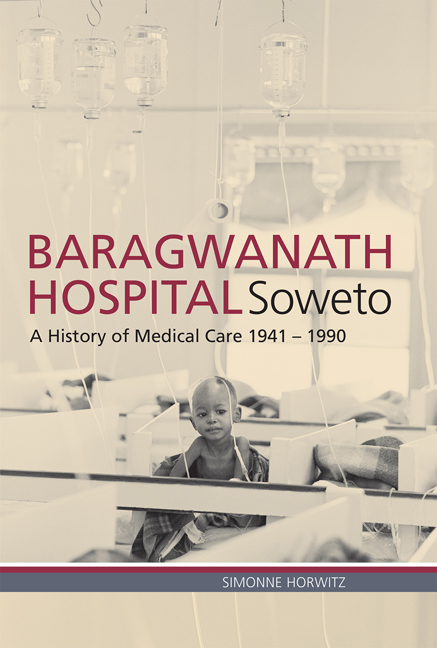Book contents
- Frontmatter
- Contents
- Acknowledgements
- List of Illustrations
- List of Abbreviations
- A note on terminology
- 1 Introduction: A Hospital in Soweto
- 2 From Allied Military Hospital to Urban African Hospital
- 3 Apartheid and Administration: The Hospital, Provincial Administration and the University of the Witwatersrand
- 4 Missionaries, Clinicians, Activists and Bara Boeties: The Doctors of Baragwanath Hospital
- 5 Black Nurses in White: The Nurses of Baragwanath Hospital
- 6 Chronic contradictions: The struggle of Baragwanath in the 1980s
- 7 Baragwanath's Transition and Legacy
- Bibliography
- Index
- Plate Section
5 - Black Nurses in White: The Nurses of Baragwanath Hospital
Published online by Cambridge University Press: 20 April 2018
- Frontmatter
- Contents
- Acknowledgements
- List of Illustrations
- List of Abbreviations
- A note on terminology
- 1 Introduction: A Hospital in Soweto
- 2 From Allied Military Hospital to Urban African Hospital
- 3 Apartheid and Administration: The Hospital, Provincial Administration and the University of the Witwatersrand
- 4 Missionaries, Clinicians, Activists and Bara Boeties: The Doctors of Baragwanath Hospital
- 5 Black Nurses in White: The Nurses of Baragwanath Hospital
- 6 Chronic contradictions: The struggle of Baragwanath in the 1980s
- 7 Baragwanath's Transition and Legacy
- Bibliography
- Index
- Plate Section
Summary
To lighten the darkness of ill health over Africa is the wide vision which Baragwanath Hospital has for its nurses. This is depicted in its badge which shows a radiant lamp, the symbol of nursing, casting light over the whole continent. This can be true if all service given in this great hospital springs from real desire to serve the sick with kindness and gentleness, as well as with efficiency and good organisation.
These words of Wendy Petersen, senior principal of the Baragwanath Nursing College from 1954 to 1963, capture the way that the white nursing establishment and hospital administration characterised the role of black nurses in South Africa. The notion that nurses would bring to the world not only good health but also ‘light’ – which here implies a Western-educated outlook – runs through the history of black nursing in South Africa and across the continent. Nursing was one of the most important avenues for African women to enter paid employment and find independent careers yet very little has been written on the history of nursing in South Africa; about how black nurses saw their role; what inspired and motivated them; their perspectives on nursing; or how nurses functioned within the hospital system during apartheid. This chapter shows the important role that nurses played in the history of Baragwanath. Nurses were the backbone of the hospital, the most numerous of the staff, and a group without whom all services at the hospital would have ground to a halt. A focused discussion of nurses at Baragwanath brings the voices of individual, mostly black, nurses to the fore and gives us insight into how they acted in the contradictory settings of the apartheid state. Within structures that sought to oppress black people, especially women, nursing offered them access to the labour market and increasing status and responsibility, albeit as part of the framework of racial segregation and separate development. The number of black nurses at Baragwanath continued to rise throughout the apartheid era.
- Type
- Chapter
- Information
- Baragwanath Hospital, SowetoA history of medical care 1941–1990, pp. 119 - 160Publisher: Wits University PressPrint publication year: 2013

